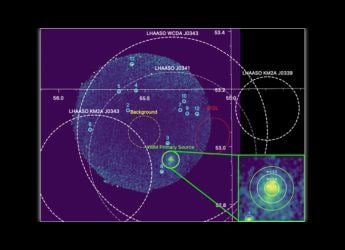- Home
- Science
- Science News
- Astronomers Detect Smallest Known Clump of Pure Dark Matter Using Gravitational Lensing
Astronomers Detect Smallest Known Clump of Pure Dark Matter Using Gravitational Lensing
A pure dark matter clump about a million solar masses and 10 billion light-years away has been detected through Einstein ring lensing.

Photo Credit: Space.com
Einstein ring in infrared with colorful radio emission of a compact object overlaid
Astronomers have found what could be the smallest clump of pure dark matter yet detected. The object has about one million times the mass of our Sun, yet emits no light. It lies roughly 10 billion light-years away and was spotted through a tiny gravitational distortion in an Einstein ring (a ring-shaped gravitational lens) around a more distant galaxy. Its apparent lack of stars suggests a “pure” dark matter clump without any luminous matter.
Gravitational lensing reveals hidden mass
According to two separate papers, the Einstein ring was imaged into unprecedented detail with a global array of radio telescopes used by astronomers. Detailed algorithms were then used to create a gravity map of the lensing image and exposed a small notch in the radio emission of the ring. Such a small distortion can not be induced by anything that is not visible and its mass is approximately one million solar masses. That is approximately 100 times lighter than the lightest object observed by this method.
New directions for dark matter research
The fact that the object does not emit any light makes astronomers prefer a dark-matter clump explanation to an ordinary galaxy. Assuming this, it would represent the smallest such dark-matter halo so far revealed - more than 100 times lighter than the lightest known. Cold dark matter models have slowly moving particles capable of forming small starless halos.
The discovery of this single clump is not surprising as per theory: the identification is which the authors of the study, Devon Powell, explained that they expect that more should be discovered by astronomers. According to Chris Fassnacht, a member of the team, the discovery of low-mass objects plays a crucial role in learning the nature of the dark matter.
Get your daily dose of tech news, reviews, and insights, in under 80 characters on Gadgets 360 Turbo. Connect with fellow tech lovers on our Forum. Follow us on X, Facebook, WhatsApp, Threads and Google News for instant updates. Catch all the action on our YouTube channel.
Related Stories
- Samsung Galaxy Unpacked 2025
- ChatGPT
- Redmi Note 14 Pro+
- iPhone 16
- Apple Vision Pro
- Oneplus 12
- OnePlus Nord CE 3 Lite 5G
- iPhone 13
- Xiaomi 14 Pro
- Oppo Find N3
- Tecno Spark Go (2023)
- Realme V30
- Best Phones Under 25000
- Samsung Galaxy S24 Series
- Cryptocurrency
- iQoo 12
- Samsung Galaxy S24 Ultra
- Giottus
- Samsung Galaxy Z Flip 5
- Apple 'Scary Fast'
- Housefull 5
- GoPro Hero 12 Black Review
- Invincible Season 2
- JioGlass
- HD Ready TV
- Laptop Under 50000
- Smartwatch Under 10000
- Latest Mobile Phones
- Compare Phones
- Poco F8 Ultra
- Poco F8 Pro
- Huawei Mate 80 RS Master Edition
- Huawei Mate 80 Pro Max
- Huawei Mate 80 Pro
- Huawei Mate 80
- Huawei Mate X7
- Honor 500
- Asus ProArt P16
- MacBook Pro 14-inch (M5, 2025)
- Poco Pad M1
- Poco Pad X1
- Honor Watch X5
- Huawei Watch Ultimate 2
- Acerpure Nitro Z Series 100-inch QLED TV
- Samsung 43 Inch LED Ultra HD (4K) Smart TV (UA43UE81AFULXL)
- Asus ROG Ally
- Nintendo Switch Lite
- Haier 1.6 Ton 5 Star Inverter Split AC (HSU19G-MZAID5BN-INV)
- Haier 1.6 Ton 5 Star Inverter Split AC (HSU19G-MZAIM5BN-INV)

















